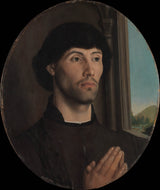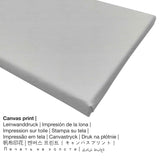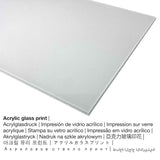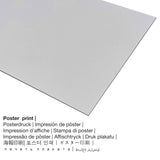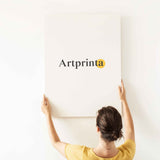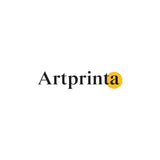Hugo van der Goes, 1475 - Eserese nke nwoke - mbipụta nka mara mma
Ụtụ gụnyere. Mbupu gbakọrọ na ndenye ọpụpụ.
Nkọwapụta ngwaahịa zuru ezu
The 15th narị afọ piece of art was created by Hugo van der Goes. The 540 A na-ese ụdị ihe nka dị otu afọ na nha: Oval, overall 12 1/2 x 10 1/2 in (31,8 x 26,7 cm); painted surface 12 1/2 x 10 1/4 in (31,8 x 26 cm). Mmanụ na osisi was used by the Dutch artist as the technique for the work of art. Nowadays, this piece of art can be viewed in in the Ụlọ ihe ngosi nka nke Metropolitan collection, which is one of the world's largest and finest art museums, which includes more than two million works of art spanning five thousand years of world culture, from prehistory to the present and from every part of the globe.. The classic art public domain masterpiece is being included with courtesy of The Metropolitan Museum of Art, New York, H. O. Havemeyer Collection, Bequest of Mrs. H. O. Havemeyer, 1929. Creditline of the artwork: H. O. Havemeyer Collection, Bequest of Mrs. H. O. Havemeyer, 1929. In addition to this, the alignment of the digital reproduction is Eserese ma nwee oke onyonyo nke 1: 1.2, which means that the length is 20% shorter than the width. The Netherlandish painter Hugo van der Goes was an artist from the Netherlands, whose art style was mainly Northern Renaissance. The Dutch painter was born in the year 1467 in Ghent, East Flanders, Flanders, Belgium and deceased at the age of 15 in the year 1482.
Ihe ebipụta nka nke ọma nke ị nwere ike ịhọrọ na:
Anyị na-enye ụdị nha na ihe dị iche iche maka ngwaahịa ọ bụla. Anyị na-ahapụ gị ka ịhọrọ n'ime ụdị ndị a:
- Akwụkwọ mmado ebipụtara (akwa akwa akwa): The Artprinta poster is a printed canvas with a fine finish on the surface. It is suited for framing your fine art print in a customized frame. Please note, that depending on the size of the poster we add a white margin of something between 2-6cm around the artwork in order to facilitate the framing.
- Metal (aluminium debond mbipụta): An Aluminium Dibond print is a print material with an impressive depth effect. The Direct Print on Aluminum Dibond is the excellent introduction to art reproductions produced on aluminum. The colors of the print are bright and vivid, the details are clear and crisp, and there’s a matte look you can literally feel.
- Mbipụta iko acrylic (nke nwere ezigbo mkpuchi iko): A glossy acrylic glass print, which is often denoted as a fine art print on plexiglass, will turn your favorite artwork into lovely décor.
- Mbipụta kwaaji: The canvas direct print is a printed cotton canvas mounted on a wood stretcher. Furthermore, a canvas print makes a attractive, enjoyable feeling. A canvas print has the advantage of being low in weight, which means that it is easy to hang up the Canvas print without the support of additional wall-mounts. Hence, canvas prints are suitable for any type of wall.
Ederede iwu dị mkpa: We try to depict our products as precisely as it is possible and to exhibit them visually on the various product detail pages. However, the tone of the print materials and the print result may diverge somehwat from the presentation on your monitor. Depending on the settings of your screen and the quality of the surface, not all colors can be printed one hundret percent realistically. Because our are printed and processed by hand, there might also be minor deviations in the motif's exact position and the size.
Ozi ngwaahịa ahaziri
| Nkewa edemede: | nka nka |
| Usoro mmeputakwa: | dijitalụ mmeputakwa |
| Usoro mmepụta: | Mbipụta UV ozugbo |
| Mmalite nke ngwaahịa a: | emepụtara na Germany |
| Ụdị ngwaahịa: | na mmepụta ihe |
| Eji ngwaahịa emebere: | foto mgbidi, nchịkọta nka (mmepụta) |
| Ndepụta: | usoro eserese |
| Njikwa oyiyi: | 1:1.2- ogologo: obosara |
| Nkọwa: | ogologo bụ 20% mkpụmkpụ karịa obosara |
| Ụdị ihe dị iche iche: | Mpempe iko acrylic (nke nwere ezigbo mkpuchi iko), mbipụta ọla (aluminium dibond), mbipụta akwụkwọ mmado (akwụkwọ kwaaji), mbipụta kwaaji. |
| Nhọrọ nke akwa akwa n'elu etiti ihe ndọtị (mbipụta akwa akwa): | 50x60cm - 20x24", 100x120cm - 39x47", 150x180cm - 59x71" |
| Mbipụta iko acrylic (nwere ezigbo mkpuchi iko) dị iche iche: | 50x60cm - 20x24", 100x120cm - 39x47", 150x180cm - 59x71" |
| Nhọrọ nha nke akwụkwọ mmado (akwụkwọ kwaaji): | 50x60cm - 20x24", 100x120cm - 39x47" |
| Ụdị mbipụta aluminom: | 50x60cm - 20x24", 100x120cm - 39x47" |
| ụba: | biko mara na nka nka enweghi fremu |
Ozi nka
| Aha eserese ahụ: | "Ihe osise nke nwoke" |
| Nhazi nka: | sere |
| Okwu nche anwụ: | nka ochie |
| Narị afọ nka: | 15th narị afọ |
| Afọ nka: | 1475 |
| Afọ nka: | ihe karịrị 540 afọ |
| Usoro nka izizi: | mmanụ n'elu osisi |
| Nha izizi (ọrụ nka): | Oval, overall 12 1/2 x 10 1/2 in (31,8 x 26,7 cm); painted surface 12 1/2 x 10 1/4 in (31,8 x 26 cm) |
| Ụlọ ihe ngosi nka: | Museumlọ ihe ngosi nka nke Obodo |
| Ebe ngosi nka: | New York City, New York, Njikota Obodo Amerika |
| E Nwere na: | Museumlọ ihe ngosi nka nke Obodo |
| Licensedị ikike: | ngalaba ọha |
| Site n'aka: | Ụlọ ihe ngosi nka nke Metropolitan, New York, HO Havemeyer mkpokọta, Arịrịọ nke Oriakụ HO Havemeyer, 1929 |
| Ebe E Si Nweta: | Mkpokọta HO Havemeyer, Arịrịọ nke Oriakụ HO Havemeyer, 1929 |
Tebụl onye na-ese ihe
| Aha onye nka: | Hugo van der Goes |
| Aha ndi ozo: | Van der Goes Hugo, Goes, Hugues Vander Goes, Hyges von der Goes, Hugues Vander-Goes disciple de Jean de Bruges, Goes Hugo van der, Hugo Vander Goes, Vander Goes, Hugues Van-Der-Goes, Hugues Vander Goes eleve de Van Eyck, Hugues van der Does, Hugo van der Goes, van der Goes |
| Gender: | nwoke |
| Obodo onye nka: | Dutch |
| Ọrụ: | Onye na-ese ihe na Netherlands |
| Obodo onye nka: | mba netherland |
| Nhazi nke onye nka: | nna ukwu ochie |
| Ụdị nke onye na-ese ihe: | Northern Renaissance |
| Akwụsị: | 15 afọ |
| Amụrụ n'afọ: | 1467 |
| Obodo ọmụmụ: | Ghent, East Flanders, Flanders, Belgium |
| Afọ ọnwụ: | 1482 |
© Nwebiisinka nke | Artprinta (www.artprinta.com)
Nkọwapụta nka site na ihe ngosi nka (© - Ụlọ ihe ngosi nka nke obodo ukwu - www.metmuseum.org)
Hugo van der Goes produced some of the most celebrated altarpieces of the Northern Renaissance. The heightened realism of this portrait, especially the beard stubble, is a hallmark of his work. By setting the man’s head against a dark interior, next to a bright window, the accentuated contrast of light and shadow enhances the modeling of the facial features. The portrait was later cut into an oval shape from a rectangular panel, which probably originally formed part of a devotional triptych. The sitter, with his hands joined in eternal prayer, directs his gaze toward the missing religious image.

